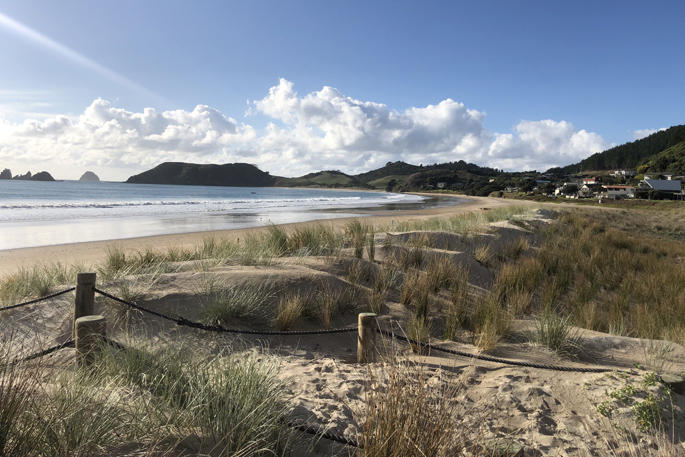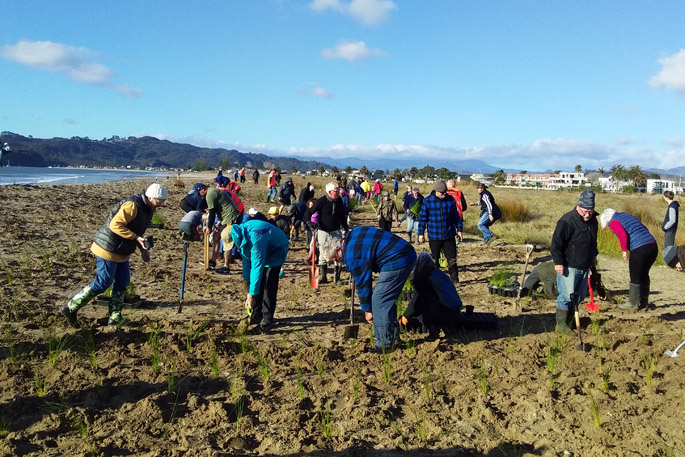As we trample across the sand towards the soothing water of the sea, do we ever give a second’s thought about the health of the dunes underneath our feet that hold coastlines together?
Well, at this time of year that’s exactly what Coromandel coastal restoration coordinator Tanya Patrick wants you to think about – and hopefully put your hand up to help restore.
“Over the years we’ve had an increase in coastal erosion and damage to the local dune systems,” says Tanya, who works for Thames-Coromandel District Council – one of the first councils in New Zealand to employ a dedicated full-time coastal restoration coordinator to focus on this task.
“A lot of coastal erosion is caused by land development, extreme weather events, high foot traffic, vehicles driving on beaches and in general, people not understanding the function and the value of a working and protected dune system.
“But we also have a big group of nature-loving residents and bach owners in the area who are passionate about restoration, conservation and ongoing improvement of dunes and wetlands and coastal areas.”
And with such help, TCDC has been planting and restoring coastlines for about 10 years, working closely with Coastcare – Waikato, part of Waikato Regional Council, the Department of Conservation and iwi, and beach care and ratepayer groups to protect and restore our coast,” says Tanya.
She’s currently getting the Coromandel’s dune planting restoration programme back-in-action after the Covid-19 lockdown, with thousands of plants ready to be planted on beaches across the peninsula’s east coast.
“The good news is Coastlands Plant Nursery held and nurtured the plants during the lockdown, so they have grown and are in pristine condition for planting.”
She has 30,000 plants to plant across the Coromandel by Labour weekend – and she’s looking for volunteers to help. To get involved, email: tanya.patrick@tcdc.govt.nz
Tanya says many people out walking and enjoying our beaches during lockdown gained a new appreciation for the dunes.
The winter planting project will see Whangapoua, Matarangi, Rings Beach, Kuaotunu, Otama, Opito Bay, Wharekaho, Buffalo Beach, Cooks Beach, Tairua, Pauanui, Whangamata and some smaller beaches receive plants.
“We focus on areas where dune restoration is much-needed, or has not occurred, and also areas where we have volunteers to help us. Some volunteers do travel to other beaches to help as well.
“And every year we go back to the previous year’s project and ‘infill’ plants and continue restoration where needed. With this year’s drought, we have to go back to replant some areas as some plants didn’t make it.
“We also have an ongoing weed management programme in place – until the area is vegetated sufficiently to push out the majority of the foreign species.”
Tanya says planting coastal native plants offers ‘soft erosion control’ by helping the dunes trap sand and rebuild naturally, helping to create a working dune system. “This creates a natural defense against erosion. The native coastal plant species also help dunes recover faster after a big storm event as they tend to hold the dunes together.
“In contrast, foreign/domestic plants and invasive species are not as capable of helping dunes recover and build naturally.”
But it’s important to note that we cannot stop erosion, says Tanya. “We can only help nature recover faster and better.”
Her advice to stay off dunes and use marked accessways to get onto beaches, rather than trampling over plantings.
“People can also help by not driving on beach reserves or dunes and not leaving green waste, grass clippings and rubbish on the beach.”




0 Comments
Leave a Comment